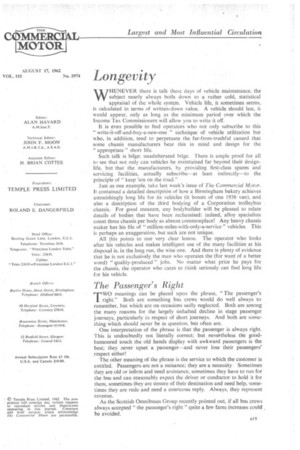Longevity
Page 25

If you've noticed an error in this article please click here to report it so we can fix it.
WHENEVER there is talk these days of vehicle maintenance, the subject nearly always boils down to a rather cold, statistical appraisal of the whole syste,m. Vehicle life, it sometimes seems, is calculated in terms of written-down value. A vehicle should last, it would appear, only as long as the minimum period over which the Income Tax Commissioners will allow you to write it off.
It is even possible to find operators who not only subscribe to this " write-it-off-and-buy-a-new-one " technique of vehicle utilization but who, in addition, tend to perpetuate the far-from-truthful canard that some chassis manufacturers bear this in mind and design for the " appropriate " short life.
Such talk is bilge: unadulterated bilge. There is ample proof for all to see that not only can vehicles be maintained far beyond their designlife, but that the manufacturers, by providing first-class spares and servicing facilities, actually subscribe—at least indirectly—to the principle of" keep 'em on the toad."
Just as one example, take last week's issue of The Commercial Motor. It contained a detailed description of how a Birmingham bakery achieves astonishingly long life for its vehicles (it boasts of one 1936 van), and also a description of the third bodying of a Corporation trolleybus chassis. For good measure, any bodybuilder will be pleased to relate details of bodies that have been rechassised: indeed, alloy specialists count three chassis per body as almost commonplace! Any heavy chassis maker has his file of " million-miles-with-only-a-service " vehicles. This is perhaps an exaggeration, but such are not unique.
All this points to one very clear lesson. The operator who looks after his vehicles and makes intelligent use of the many facilities at his disposal is, in the long run, the wise one. And there is plenty of evidence that he is not exclusively the man who operates the (for want of a better word) " quality-produced " jobs. No matter what price he pays for the chassis, the operator who cares to think seriously can find long life for his vehicle.
The Passenger's Right
TWO meanings can be placed upon the phrase, "The passenger's right." Both are something bus crews would do well always to remember, but which are on occasions sadly neglected. Both are among the many reasons for the largely unhalted decline in stage passenger journeys, particularly in respect of short journeys. And both are something which should never be in question, but often are.
One interpretation of the phrase is that the passenger is always right. This is undoubtedly not literally correct; but nevertheless the goodhumoured touch the old hands display with awkward passengers is the best; they never upset a passenger—and never lose their passengers' respect either!
The other meaning of the phrase is the service to which the customer is entitled. Passengers are not a nuisance; they are a necessity. Sometimes they are old or infirm and need assistance, sometimes they have to run for the bus and can reasonably expect the driver or conductor to hold it for them, sometimes they are unsure of their destination and need help, sometimes they are rude and need a courteous reply. Always, they represent revenue.
As the Scottish Omnibuses Group recently pointed out, if all bus crews always accepted "the passenger's right" quite a few fares increases could be avoided.












































































































